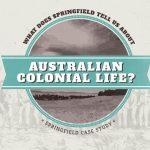Case Study Overview
Springfield is a pastoral property which was established near Goulburn, New South Wales, in 1827. It still exists today. The contents of the historic home were donated to the National Museum of Australia, and many of these are on display now in the museum. A study of this property and its historic objects can help us learn about colonial life — especially about economic, social and environmental features.
Case Study unit of work inquiry structure
There are three separate multimedia components of the inquiry unit:
- Take a quick trip through the National Museum of Australia to get a taste of the historic objects from ‘Springfield’ on display, and what they tell us about colonial life in Australia.
- Try the interactive decision maker – see if you would have been able to run a property like ‘Springfield’ and help develop Australia.
- See if you can work out what the 10 ‘Springfield’ ‘mystery objects’ are.
Key inquiry questions
- What do we know about the lives of people in Australia’s colonial past and how do we know?
- How did an Australian colony develop over time and why?
- How did colonial settlement change the environment?
- What were the significant events and who were the significant people that shaped Australian colonies?
Historical knowledge
- The nature of convict or colonial presence, including the factors that influenced patterns of development, aspects of the daily life of the inhabitants (including Aboriginal peoples and Torres Strait Islander peoples) and how the environment changed. (ACHHK094)
- The role that a significant individual or group played in shaping a colony; for example, explorers, farmers, entrepreneurs, artists, writers, humanitarians, religious and political leaders, and Aboriginal peoples and/or Torres Strait Islander peoples. (ACHHK097)
Historical skills
Chronology, terms and concepts
- Sequence historical people and events (ACHHS098)
- Use historical terms and concepts (ACHHS099)
Historical questions and research
- Identify questions to inform an historical inquiry (ACHHS100)
- Identify and locate a range of relevant sources (ACHHS101)
Analysis and use of sources
- Locate information related to inquiry questions in a range of sources (ACHHS102)
- Compare information from a range of sources (ACHHS103)
Perspectives and interpretations
- Identify points of view in the past and present (ACHHS104)
Explanation and communication
- Develop texts, particularly narratives and descriptions, which incorporate source materials (ACHHS105)
- Use a range of communication forms (oral, graphic, written) and digital technologies (ACHHS106)




